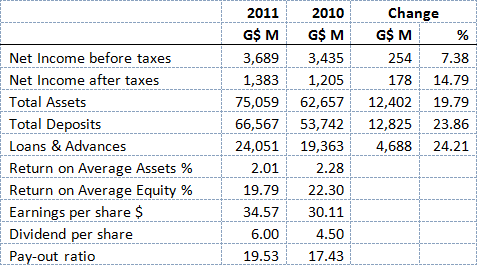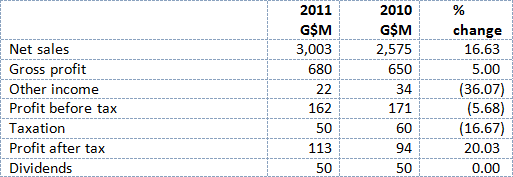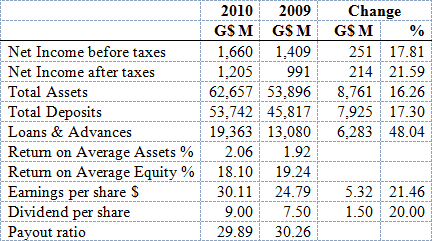Introduction
Business Page today interrupts its series on the state-owned Guyana Sugar Corporation to present an overview of the annual reports and accounts of two of the country’s financial institutions which will soon be holding their annual members’ general meetings at which the presentation of the annual reports is a major agenda item. One of these is the commercial bank, the Guyana Bank of Trade and Industry which is a licensed financial institution regulated by the Bank of Guyana under the Financial Institutions Act. The other is the New Building Society Limited, which carries on a financial business but which the Bank of Guyana claims does not fall within the act and which, despite several commitments by the Bank of Guyana and the government, remains unregulated. As a result, the bank is subject to the Single Borrowers Limit and other “strong financial regulations,” as described by no less than the Minster of Finance himself, while the NBS is not.
This is not the only note of contrast. One has to look no further than the Chairman’s reports by Mr Robin Stoby SC and Dr Nanda Gopaul of the two institutions respectively to see how they reflect the backgrounds, styles and personalities of the individuals. Both of them had good reason to be satisfied about the results of their entities. But while Mr Stoby was professional and measured, even enthusiastic at times, Dr Gopaul showed how difficult it is for him to adjust his political style to dealing with the commercial world.
He had no qualms about castigating members of the NBS as an “uninformed little group of mischief makers and pseudo intellectuals”; or about praising Housing Minister Irfaan Alli who now risks sanction by the Privileges Committee of the National Assembly for misleading the National Assembly; or making claims about the economy that are at best questionable. While Dr Gopaul claims that the Guyana currency has appreciated during the year, the GBTI Annual Report – and you would expect the bank to know – reported that the Guyana dollar market exchange rate was $202.75 compared with $201.75 during 2008. He also said that the fiscal deficit was at its lowest in 10 years. Perhaps he has been wrongly advised by his Finance Committee comprising former Commissioner of Police Mr Floyd McDonald and trade unionist Mr Kenneth Joseph.
It also goes beyond the two chairmen. The directors of GBTI are all experienced, private sector persons, while those of the NBS with one exception are all connected, directly or indirectly with the ruling party. This necessarily flows through to the quality of governance which has been a major and continuing issue at the NBS, particularly in relation to proxy voting, pensions for directors, and a modern code of corporate governance.
GBTI
The annual report of the GBTI which will be holding its meeting on Monday, April 19, 2010 shows the bank continuing a remarkable run in which since 2006, net income before taxes has increased by 25.8% in 2009, 14.8% in 2008 and 23.9% in 2007, making for a cumulative increase since 2006 of 78.8%. Because of the tax effect, after-tax profits have increased cumulatively over the same period by 95.9%.
The Beharry family holds a 61% controlling interest with the remainder of the shares spread among hundreds of members, but the actual number and any other significant concentrations are not disclosed in the annual report.
Earnings per share for the year were 24.8% in 2009, marginally up from the 23.5% in 2008. With the company’s shares trading at $140, the P/E ratio, a popular investment measure, has improved slightly, to 5.6, making the security one of the most attractive in the domestic market. One area of significance is the increase in the effective rate of taxation which for 2009 is 29.7%, compared with an effective rate of 16.0% in 2008. The corporation tax charge for the year is 26.2%, compared with 13.6% in 2008. Readers are aware that the nominal rate of corporation tax on banks, commercial and telecommunication companies is 45%. As a result of the higher effective rate of tax, the Return on Average Assets and Average Equity have both declined, albeit marginally.
The interest earned on the average of net loan balances declined from 13.4% to 13.1% while the average interest paid on deposits was 2.2%, compared with 2.6% in 2008. This apparently low interest rate is in some significant measure due to the high level of non-interest bearing demand deposits which averaged more than $10 billion during the year. The bank continues to earn significant amounts from foreign exchange transactions with Exchange Trading Gains increasing from $664M or 18.4% of total income in 2008 to $733 million or 19.1% in 2009. As this column noted last year, the gains on foreign exchange alone cover the total staff costs of $612.6 million, which is a decrease from the previous year.
The continuing good run allows Chairman Robin Stoby to announce for yet another year, “the highest dividend payout in absolute terms in the bank’s long history.” At $7.5 per share, total dividends in 2009 will represent 30.3% of the year’s distributable profits, compared with 25.5% in 2008 and 25.1% in 2007. By comparison, the dividend payout ratio of Republic Bank Guyana Limited for 2009 was 41.2%.
Highlights
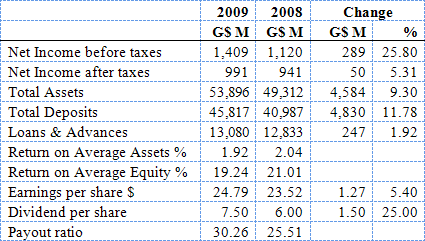
The bank’s deposits increased in line with the growth in deposits of the financial sector, thus allowing it to retain a 21% market share of deposits. Its market share of loans however declined from 22% to 20.3%. The bank’s financial condition remains very strong and shareholders’ funds have increased from $4.7 billion to $5.7 billion.
Mainly due to what is described as capital work-in-progress of $4.1 billion, the value of property, plant and equipment has increased from $3.8 billion to $5.6 billion. In addition to the new head office, the bank is also building a new branch at Diamond on the East Bank of Demerara. At the sod-turning in 2008 the bank had announced the cost of the new head office building at $2.6 billion. Unless there are some other capital developments that have not been announced, it seems that there has been a significant cost overrun on the head office. The financial statements also reveal that the bank had actually exceeded the Single Borrower Limit by its investment in Government of Trinidad and Tobago Sovereign Bonds, although it fails to disclose the amount of the excess.
As they receive the report of the continued successful performance of the bank, shareholders are likely to overlook these matters, as well as the sudden departure of the bank’s CEO in October 2009. The meeting should be quite a quiet affair.
The New Building Society
After a break of two years when the directors took the annual meeting to Berbice, the annual general meeting of the NBS will return to the Pegasus Hotel next Saturday at 1.30 pm. The directors will report a profit of $588 million, describing it as an increase of 97% following a write-off in 2008 of a $200 million exchange loss on its sterling investment. According to the audited Statement of Income the profit for the preceding year was $487 million, so that the increase in profit for the current year is 9.6%.
Highlights
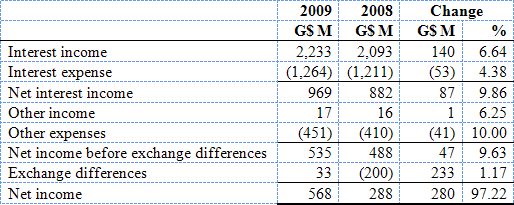
As is evident, the increase in net income before exchange difference was 9.63% but after taking account of an exchange gain in 2009 compared with an exchange loss in 2008, the change in net income is 97.2%. Just for the benefit of the financially minded, the accounting treatment of the gain is not in accordance with the rules of accounting.
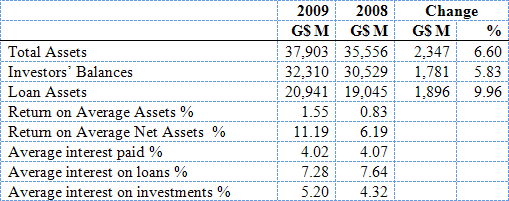
Total assets of the NBS increased by 6.6% compared with 9.3% of the GBTI while its investors’ balances – largely equivalent to depositors’ balances – increased by 5.8%, compared with GBTI 11.9%. Despite this, and due to its tax exempt status, no reserve requirement and more discretionary provisioning rules, the NBS pays higher rates of interest on deposits and yet charges lower rates on its loans.
There is no doubt that the investments in the Berbice Bridge Company Inc are attractive, even for a tax-exempt entity. The issue has been concentration. Having acquired $1,520,000 of such investments from CLICO in 2009, the total of $1,870,000 represents 34.9% of the reserves at the end of the year. As a prudential rule, the Financial Institutions Act limits any single investment by financial institutions to 25% of their capital base.
The Society’s pension fund recorded unfunded obligations of $21.8M compared to a surplus of $21.5M, a significant turnaround of over 200%. No mention is made of the cause of this decline. Accounting rules have allowed a significant larger obligation to be presented in the financial statements.
The last time the NBS had a meeting at the Pegasus, there was quite a furore. It is unlikely that history will repeat itself.

